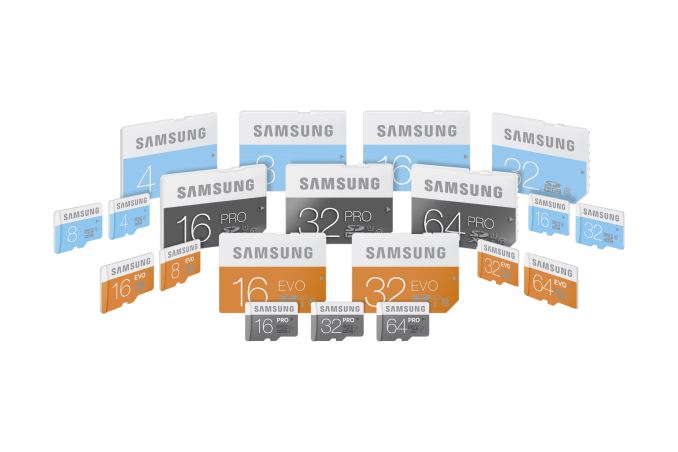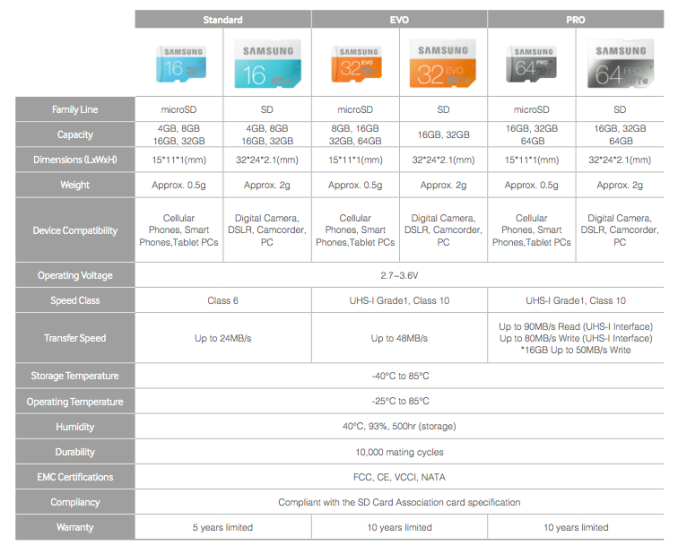Samsung Releases Standard, EVO and PRO SD Cards
by Kristian Vättö on April 7, 2014 10:05 AM EST
With the rapid decrease of NAND prices in the last few years, the SD card market has more or less become a commodity with very little differentiation. We don't typically note minor product releases but we'll make an exception here given that this one is a bit more significant than the average.
Samsung is revamping their whole SD card lineup at once by simplifying it into three product series: Standard, EVO and the PRO. Those who are familiar with Samsung's SSDs notice that the EVO and PRO brands are adopted from the 840 SSD series, which makes sense given Samsung's success in the SSD space and the brand they've been able to build with the 840 EVO and Pro.
Samsung's goal with the branding is to make it as easy as possible for the customer to select an SD card that fits their needs because oftentimes SD cards are marketed using the class system (like class 10), which may not tell much to an average SD card shopper. Electronics stores tend to have isles of SD cards available and differentiating in that space is extremely hard, so Samsung hopes that its simple branding will help to boost sales. Each brand also has a unique color (turquoise for Standard, orange for EVO and black for PRO) that aims to simplify branding even further and to allure customers (we all like vibrant colors, don't we?).

At the low level these are all MLC NAND designs but with varying quality of NAND being used. In fact only a small portion of the NAND meets the requirements for SSDs, the rest of the NAND is used in products where endurance and performance aren't as critical (such as USB drives, SD cards, eMMC...).
Update: As some of you speculated in the comments, the Standard and EVO models do in fact use TLC NAND, while MLC NAND is only used in the PRO model. The info we got from Samsung during the initial briefing was incorrect and we apologize for the confusion.
All in all, the SD card market as a whole is quite uninteresting. When you can get a decent SD card for a tenner or two, it's logical that not much time is spent on the purchase decision or research. Simple branding can help with that and the high-end niche for the PRO model does exist, but I still believe that the average buyer will just get the cheapest card available or the one that is recommended by the sales rep.











46 Comments
View All Comments
jgstew - Monday, April 7, 2014 - link
The SD Card market and the USB Flash drive market might not be that interesting from a typical consumer position, but when you are wanting to buy the fastest option available, it is very hard to find reliable benchmarks and reviews of these devices. It is also very hard to find IOPS figures for these devices and not just maximum throughput.uhuznaa - Monday, April 7, 2014 - link
An ideal environment to make a brand work. Samsung has a great reputation when it comes to hardware, and for good reasons. This is a good strategy.It's software and design they utterly suck at (at least for western tastes) but both don't apply to SD cards. Good move.
Pix2Go - Thursday, April 10, 2014 - link
Agreed on the need for speed. I find the write speed of cards to be of far more importance in a DSLR than the read speed. Careful scrutiny of the specs of the camera will show that the buffer-to-card transfer rate has a maximum value, regardless of how fast the memory card can write. As long as the write speed of the card exceeds the write speed of the camera, you'll get maximum performance.I shoot RAW, with a Nikon D7000, and I'll invariably fill the (notoriously small, about 10 frame) in- camera buffer no matter the speed of memory I use. The D7000 has a max write-to-memory speed of about 26-28 MB/s. (Proof here: http://www.robgalbraith.com/camera_wb_multi_page8e... ) Boy how I wish that Sandisk card could cure my buffer woes - I've missed shots waiting on the camera to write to memory. Regrettably, the only real sure cure is a new camera body.
kyuu - Monday, April 7, 2014 - link
Your perspective on SD cards seems a bit skewed, Mr. Vatto. Besides the fact that most DSLR users (or even those who use point-'n-shoots somewhat seriously) with any sort of knowledge on the subject are hardly going to go with the cheapest one or the one the sales rep recommends, cameras aren't the only use for SD cards.In my case, I'm specifically looking at SD cards to expand the capacity of my Dell Venue 8 Pro (and any future Windows tab). Since these aren't just going to hold media, but also run applications, performance is rather important -- random IO more than sequential, but no manufacturer rates their SD cards for random performance, it seems.
So while you may be right that the SD card market is uninteresting for the general mass market customer, it's a little different for more knowledgable and specialized buyers (like, say, the readers of this site?).
I also wonder why we don't see tablets with full-sized SD card slots instead of microSD; it seems like there should be room for it, and full-sized SD cards get you more space and better performance for less money.
hojnikb - Monday, April 7, 2014 - link
Considering how "simple" eMMC controllers usually are, IOPS speeds almost always sux (especially write). Because vast majority of users only need fast sequential speeds, its kinda pointless making a controller, that will perform good with random data or even finetuning existing ones for better random speeds at a cost of sequential.kyuu - Tuesday, April 8, 2014 - link
I would argue that it makes a lot of sense when you're talking about a controller for anything but a camera.hojnikb - Tuesday, April 8, 2014 - link
There is a driver floating around (altough not developed anymore, so i'm not sure about win8 compatability) that pretty much solves the random write issue with sd cards or any flash media for that matter.It's called flashfire and was developed at the time, when EeePCs were popular (the ones with small ssds). Being very slow at random speeds (no dram and really crappy controllers) flashfire really helped with stuttering and whatnot.
diud - Monday, April 14, 2014 - link
The eMMC storage in the Bay Trail Windows 8 tablets I've seen have decent random I/O: 10-20 MB/s 4K writes/reads. Better than most HDDs. Sequential speeds I've seen go as high as 170 MB/s.popej - Monday, April 7, 2014 - link
I fully support your point of view. What really differentiate SD cards is maximum IOPS. It can be as low as 10 for a otherwise very fast card.I think Samsung can make good cards, I have noticed up to 600-800 write IOPS for their micro-SD.
micksh - Monday, April 7, 2014 - link
XDA-developers users measured random IO performance. It matters because they run Android OS from SD card.http://forum.xda-developers.com/showpost.php?p=416...
Basically, only Sandisk class 4 and class 2 cards show good random IO speed. Note that they tested microSD cards, but I think it's likely that full SD cards will be similar.
And for my camera I buy Sandisk Extreme Pro 95MB/s SD cards. They allow 80MB/s write speed in 16GB version. Samsung 16GB cards in this article seem to be limited to 50MB/s write speed. 32GB would be too big for me as I prefer not to hold all eggs in one basket; I have several 8 and 16GB cards.